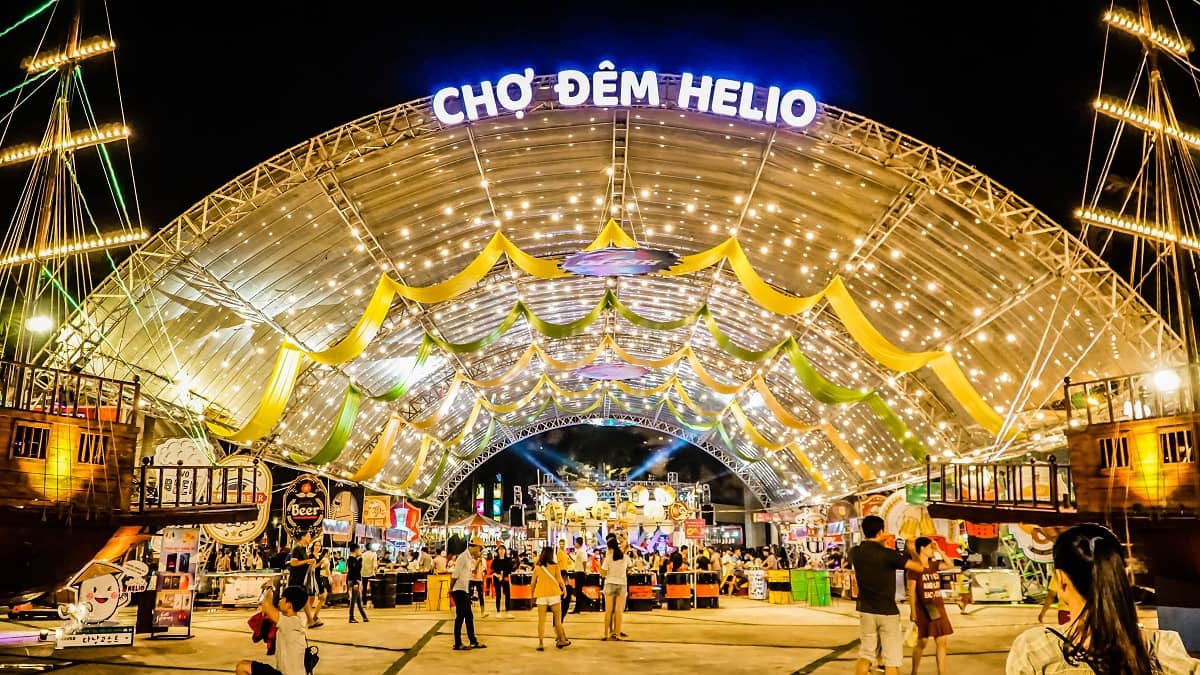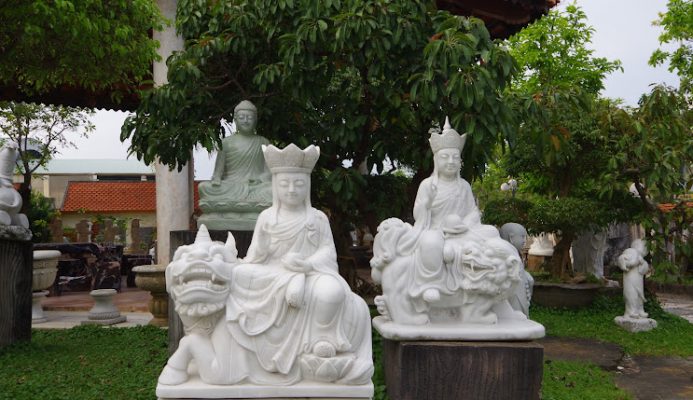
Non Nuoc Stone Carving Village
Explore Non Nuoc Stone Carving Village, the heart of Vietnam’s traditional stone carving artistry. Discover exquisite sculptures and rich history in this cultural gem. A must-visit destination for art and culture enthusiasts traveling from all over the world. Follow Ula Travel and start your journey to explore this interesting village!
I. Introduction to the Non Nuoc Stone Carving Village
Nestled at the foot of the Marble Mountains in Da Nang, lies the Non Nuoc Stone Carving Village, a gem of cultural heritage and artistic craftsmanship. For centuries, this village has been renowned for its exquisite stone carvings, a tradition passed down through generations of skilled artisans.
The Non Nuoc Stone Carving Village is not just a hub of artistic activity; it is a testament to the enduring cultural legacy of Vietnam. The artisans here transform solid marble into intricate sculptures, ranging from religious statues to intricate pieces of home decor. These creations are not only a reflection of the artisans’ remarkable skills but also a deep connection to the spiritual and cultural essence of the region.
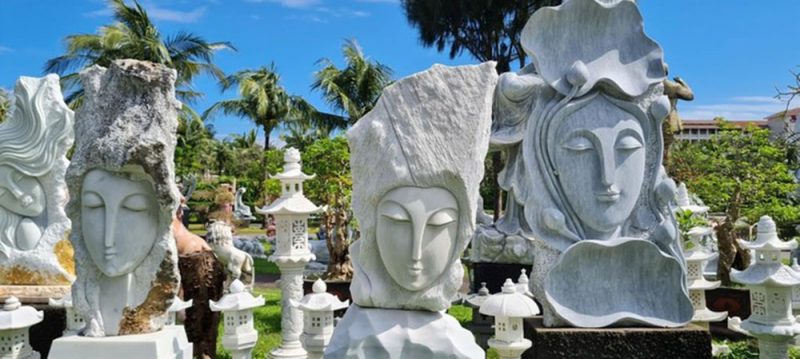
Non Nuoc stone carving village is a famous tourist destination in Da Nang
Famed for its high-quality marble, sourced directly from the nearby Marble Mountains, Non Nuoc Village has earned international acclaim. Visitors from around the world come to witness the artistry firsthand, often leaving with a piece of Vietnam’s cultural heritage. The village’s significance extends beyond its economic contributions; it stands as a living museum where the ancient art of stone carving continues to thrive in the modern world.
In Non Nuoc Stone Carving Village, every carved piece tells a story, and every artisan’s touch brings history to life, making it a must-visit destination for those seeking a deeper understanding of Vietnamese culture and craftsmanship.
II. History of the Non Nuoc Stone Carving Village
1. The Formation and Development of Non Nuoc Stone Carving Village
Non Nuoc Stone Carving Village, located at the foot of the Marble Mountains in Da Nang, boasts a history that dates back over 400 years. This renowned village began its journey in the 17th century, founded by craftspeople who migrated from Thanh Hoa province. They brought with them the rich tradition of stone carving, which they adapted and perfected using the abundant marble found in the Marble Mountains.
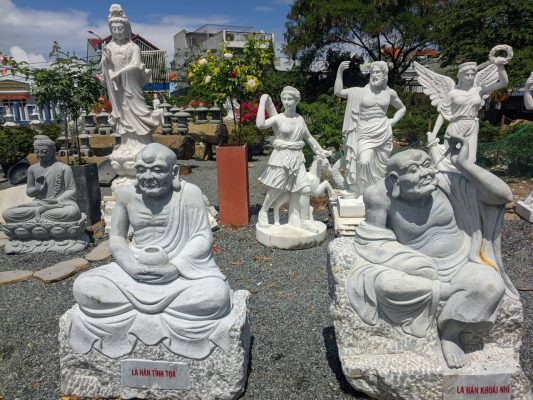
Non Nuoc traditional craft village has a history of more than 400 years
Throughout the centuries, the village has evolved from a small community of artisans into a thriving hub of craftsmanship. The skills and techniques have been passed down through generations, ensuring the preservation and enhancement of this unique art form. Today, Non Nuoc Stone Carving Village is not only a local treasure but also an internationally recognized center of traditional Vietnamese stone art.
2. Stories Surrounding the Village
The history of Non Nuoc Stone Carving Village is interwoven with fascinating stories and legends. One popular legend tells of a mystical dragon that inhabited the Marble Mountains, bestowing blessings upon the village and its people. According to the tale, the dragon’s presence infused the marble with magical properties, making it especially suited for carving intricate and lifelike sculptures.
III. Stone Carving Art
1. Production Process and Traditional Carving Techniques
Stone carving in Non Nuoc Village is steeped in rich tradition and craftsmanship. The process begins with selecting high-quality stones, typically marble, granite, or limestone, known for their durability and suitability for intricate carving. Artisans first sketch designs directly onto the stone or use templates for precision.
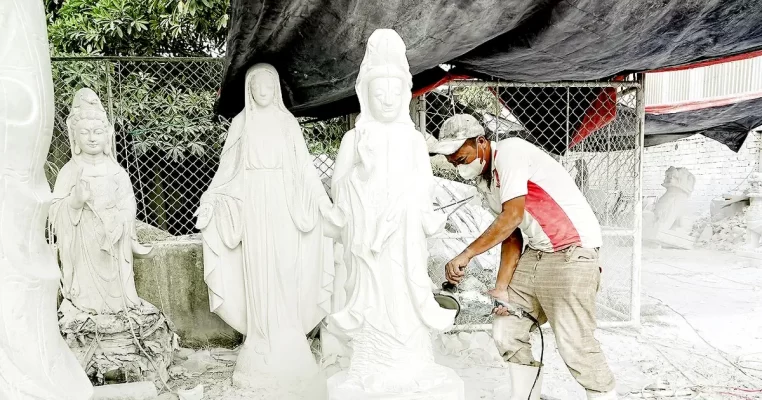
The materials and stone carving process are done very meticulously
Traditional carving techniques involve meticulous hand-carving using chisels, hammers, and other specialized tools. These tools allow artisans to achieve intricate details and textures, transforming raw stone into intricate sculptures and artworks. The process requires patience and skill, often passed down through generations within families in Non Nuoc Village.
Are you looking for: Da Nang tours
2. Types of Stones Used and Reasons for Popularity
Non Nuoc artisans primarily work with several types of stone, each chosen for its unique qualities:
- Marble: Renowned for its smooth texture and ability to hold fine details, marble is a preferred choice for creating statues and busts that require intricate facial features and flowing drapery.
- Granite: Known for its durability and ability to withstand outdoor conditions, granite is used for larger sculptures and architectural elements in gardens and public spaces.
- Limestone: Often used for its softer texture, limestone is suitable for both small and medium-sized sculptures and is prized for its ease of carving and versatility in finishing.
3. Prominent and Unique Sculptures of Non Nuoc Stone Carving Village
Non Nuoc Village boasts a rich collection of distinctive stone sculptures, reflecting both traditional Vietnamese motifs and modern influences. Some of the standout sculptures include:
- Mythological Figures: Carved with intricate details depicting legendary figures from Vietnamese folklore, these sculptures often adorn temples and pagodas, embodying cultural heritage.
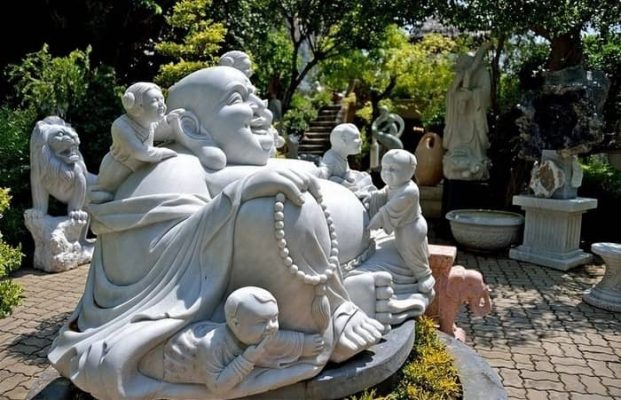
Sculpture depicting Maitreya Buddha in Buddhism
- Buddhist Statues: Revered for their spiritual significance, Buddhist statues carved in Non Nuoc Village are characterized by serene expressions and graceful postures, attracting spiritual seekers and art enthusiasts alike.
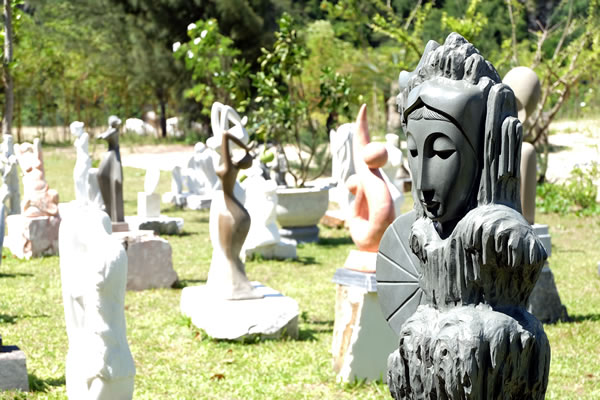
A sculpture with the breath of contemporary art
- Contemporary Artworks: In recent years, Non Nuoc artisans have expanded their repertoire to include contemporary sculptures that blend traditional techniques with innovative designs, catering to the diverse tastes and preferences of modern art collectors.
IV. How to Get There
1. Location of Non Nuoc Stone Carving Village
Non Nuoc Stone Carving Village is situated at the foot of the Marble Mountains, also known as Ngu Hanh Son, in Da Nang, Vietnam. This historic village is located approximately 8 kilometers southeast of Da Nang city center, making it easily accessible for tourists.
2. Detailed Directions from Major Cities Like Da Nang and Hoi An
From Da Nang
By car or taxi:
- The most convenient way to reach Non Nuoc Stone Carving Village from Da Nang is by car or taxi. The journey takes about 15–20 minutes.
By Motorbike:
- Renting a motorbike is a popular and adventurous option for tourists.
- Follow the same route as by car, which allows for flexibility in stopping at various scenic spots along the way.
By public bus:
- Take bus number 1 from Da Nang city center towards Hoi An.
- Get off at the Marble Mountains stop, from where the village is a short walk away.
From Hoi An
By car or taxi:
- The distance from Hoi An to Non Nuoc Stone Carving Village is about 20 kilometers, and the journey takes approximately 30 minutes.
By Motorbike:
- Rent a motorbike in Hoi An and take the scenic coastal route along Lac Long Quan Street.
- This trip offers beautiful views of the coastline and takes about 30 minutes.
By shuttle bus:
- Many tour operators in Hoi An offer shuttle bus services to the Marble Mountains.
- These can be booked through hotels or travel agencies and usually include a round-trip trip.
V. Things to Do in Non Nuoc Stone Carving Village
1. Attractions around Non Nuoc Stone Carving Village
- Non Nuoc Stone Carving Village Itself: The heart of the village is a vibrant community of skilled artisans working on various stone sculptures. Visitors can witness the intricate process of stone carving and see masterpieces ranging from small souvenirs to large statues.
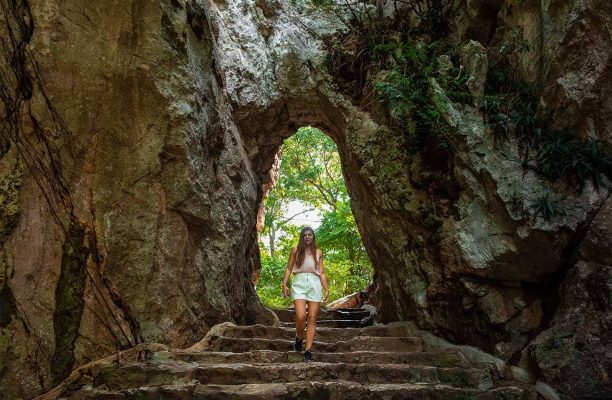
Marble Mountains
- Marble Mountains: Located just a short distance from the village, the Marble Mountains are a cluster of five marble and limestone hills. Each mountain is named after one of the five elements: Kim (metal), Thuy (water), Moc (wood), Hoa (fire), and Tho (earth). The mountains are home to numerous caves, tunnels, and temples, providing a scenic and spiritual escape for visitors.
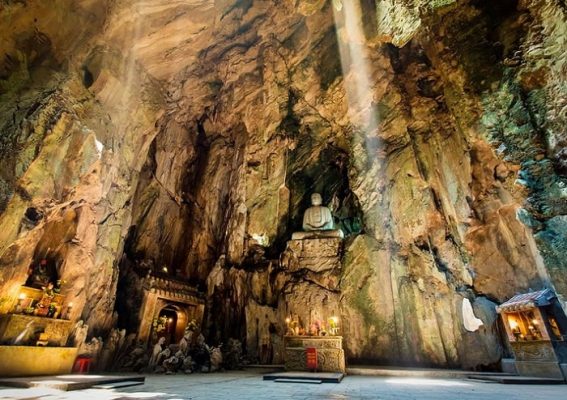
Hoa Nghiem Cave
- Hoa Nghiem Cave: One of the most famous caves within the Marble Mountains, Hoa Nghiem Cave is known for its impressive stalactites and stalagmites. The cave also houses several Buddhist statues and altars, making it a serene spot for contemplation and worship.
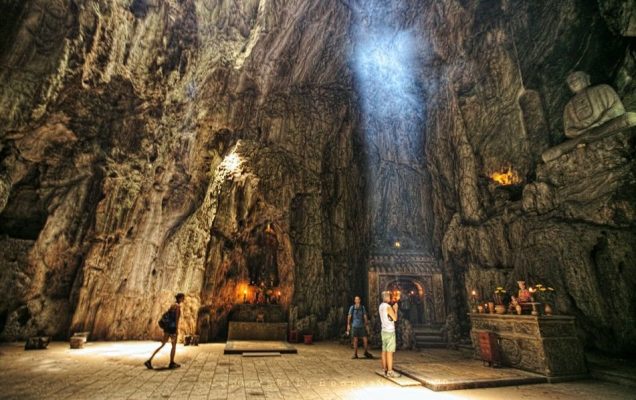
Huyen Khong Cave
- Huyen Khong Cave: Another notable cave in the Marble Mountains, Huyen Khong Cave, features a large open space with natural light streaming through holes in the ceiling, creating a mystical atmosphere. It’s a must-visit for its unique ambiance and the historical Buddhist relics found within.
Do not miss: Da Nang to Hue – Unexpected Trip You’ll Love
2. Engaging Activities for Tourists
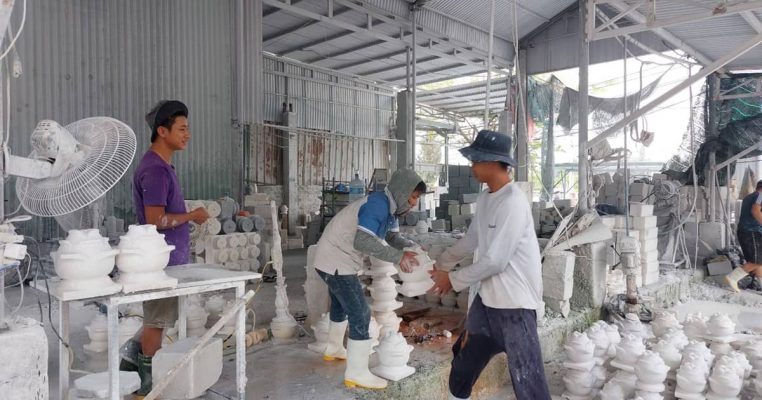
Visitors can visit stone workshops
Touring Stone Carving Workshops: Visitors can tour various workshops within the village to observe the stone-carving process up close. Artisans are often happy to explain their techniques and the history behind their craft. This hands-on experience provides a deep appreciation for the skill and dedication involved in stone carving.
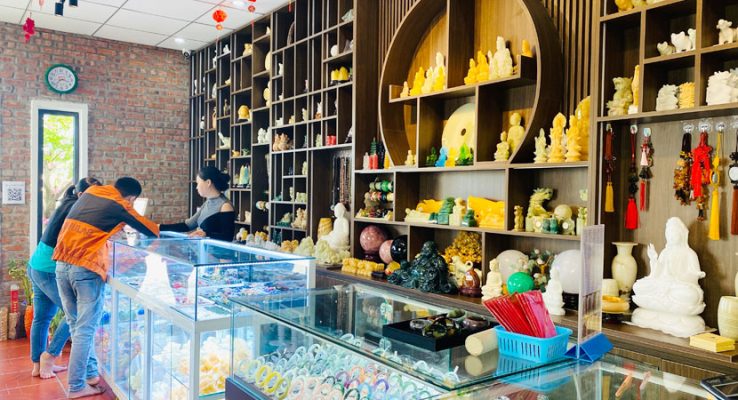
Visitors can buy products made from stone as souvenirs to take home
Shopping for stone products: The village offers a wide array of stone products for sale, including jewelry, statues, home décor items, and religious artifacts. Purchasing these unique items not only supports local craftsmen but also provides a tangible memory of the visit. Many shops offer custom engraving services, allowing visitors to personalize their souvenirs.
Participating in Stone Carving Classes: Some workshops offer short courses or demonstrations where visitors can try their hand at carving. Under the guidance of experienced artisans, tourists can create their own small stone carvings, providing a unique and memorable experience.
Start your journey with: Da Nang to Hoi An in 4 Days
3. Cultural Experiences
Exploring Local Temples and Pagodas: The area around Non Nuoc Stone Carving Village is dotted with ancient temples and pagodas. Exploring these sites offers a glimpse into the spiritual life of the local community and the historical significance of the region.
Attending local festivals: If visiting during certain times of the year, tourists can participate in local festivals and cultural events. These celebrations often feature traditional music, dance, and food, offering an immersive cultural experience.
Photography and Scenic Walks: The natural beauty of the Marble Mountains and the artistry within the village provide ample opportunities for photography. Scenic walks around the mountains and the village streets allow tourists to capture the essence of Non- Nuoc’s charm.
Click here: Central Vietnam Wonders Tour
VI. Fantastic Souvenirs and Where to Find Them
1. Suggested Souvenirs
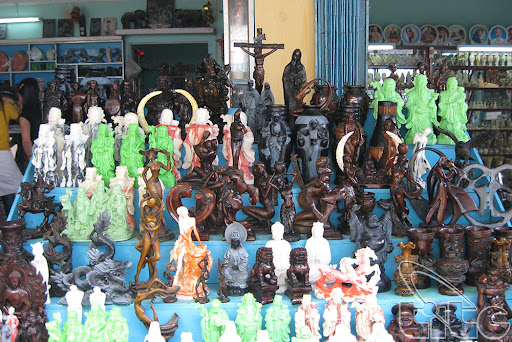
There are many things tourists can buy as souvenirs
Non Nuoc Stone Carving Village is renowned for its exquisite stone sculptures, which make perfect souvenirs or gifts. Here are some suggested items you might consider purchasing:
- Buddha Statues: These statues come in various sizes and styles, ranging from small figurines to larger, more detailed pieces. They are crafted with precision and embody a sense of tranquility and spirituality.
- Animal Figures: From majestic lions to graceful cranes, the animal sculptures are a favorite among tourists. These pieces are intricately carved and often represent different cultural symbols and meanings.
- Garden Ornaments: Stone lanterns, birdbaths, and fountains are popular choices for those looking to add a touch of elegance to their gardens. These items are both functional and decorative.
- Jewelry and Accessories: Smaller items like stone bracelets, necklaces, and rings are great for personal use or as gifts. These pieces are beautifully crafted and highlight the unique qualities of the local stone.
- Decorative Panels and Plaques: These are perfect for home decor, featuring intricate designs and patterns that showcase traditional Vietnamese artistry.
- Religious Icons: For those interested in religious artifacts, the village offers a variety of sculptures depicting different deities and religious symbols, which are crafted with great reverence and skill.
You will be like: Discover Central Vietnam Tour in 6 Days
2. Reputable Places to Purchase High-Quality Products
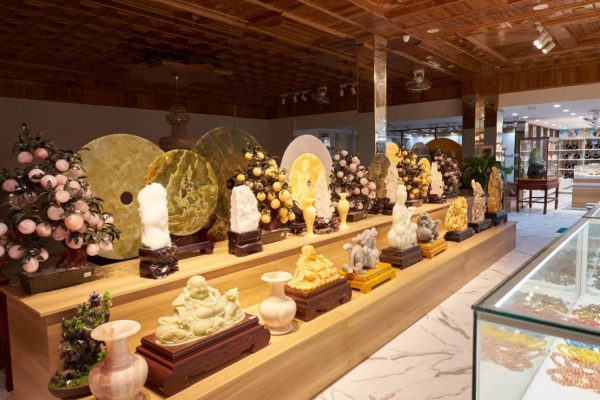
You will always find the right product in the showrooms
When shopping for stone carvings in Non Nuoc Stone Carving Village, it’s essential to find reputable places to ensure you are getting high-quality products. Here are some trusted locations:
- Local Artisan Workshops: Visiting the workshops where the artisans create their masterpieces is an excellent way to see the process firsthand and purchase directly from the source. This ensures authenticity and often allows for custom orders.
- Village Marketplaces: The village has several marketplaces where multiple vendors sell their stone carvings. These markets are great for comparing different styles and prices, and you can often find unique pieces.
- Established Shops: There are several well-known shops in the village that have been in business for many years. These shops are known for their quality and authenticity. Look for stores with good reviews and longstanding reputations.
- Non Nuoc Stone Carving Cooperative: This cooperative brings together multiple artisans and ensures that their products meet specific quality standards. Purchasing from the cooperative helps support the local community and guarantees high-quality craftsmanship.
- Art Galleries: Some art galleries in the nearby city of Da Nang also feature stone carvings from Non-Nuoc. These galleries curate high-quality pieces and often provide additional context about the artists and their work.
- Online Stores: For those who prefer to shop from home, some reputable artisans and shops offer their products online. Ensure the website is legitimate, and check for customer reviews to verify the quality of the items.
More details: Central Vietnam Wonders Tour
VII. Tips for Visiting Non Nuoc Stone Carving Village
1. The Best Time to Visit Non Nuoc Stone Carving Village
- Optimal Seasons: The best time to visit Non Nuoc Stone Carving Village is during the dry season, which typically runs from March to September. During these months, the weather is generally pleasant, with less rain, allowing for a more comfortable exploration of the village and its surroundings.
- Avoiding Peak Tourist Season: If you prefer a quieter experience, try visiting in the shoulder months of March–April or September–October. These periods offer good weather while avoiding the large crowds that peak during the summer holidays.
2. Cultural and Etiquette Considerations
- Respect for Local Customs: Non Nuoc Stone Carving Village is not only a tourist destination but also a working village with deep cultural roots. Always ask for permission before taking photos of people, especially artisans at work.
- Dress Appropriately: While there is no strict dress code, it is advisable to dress modestly out of respect for local customs. Comfortable, lightweight clothing that covers the shoulders and knees is recommended, especially if you plan to visit any nearby temples.
- Polite Interactions: Vietnamese people are generally friendly and welcoming. A simple greeting like “Xin chào” (hello) can go a long way. Learning a few basic phrases in Vietnamese can enhance your interaction with locals and show respect for their culture.
In conclusion, Non Nuoc Stone Carving Village stands as a testament to the rich cultural heritage and artistic ingenuity of Vietnam. This village, with its exquisite stone sculptures and deeply rooted traditions, offers a unique glimpse into the world of Vietnamese craftsmanship. Whether you’re an art enthusiast, a history buff, or simply a traveler seeking authentic cultural experiences, Non Nuoc Village provides a compelling reason to visit. Embrace the opportunity to witness the intricate artistry, learn about the fascinating history, and bring home a piece of this timeless craft. Plan your visit to Non Nuoc Stone Carving Village and immerse yourself in an unforgettable journey through Vietnam’s artistic legacy.
See more: Da Nang travel tips



